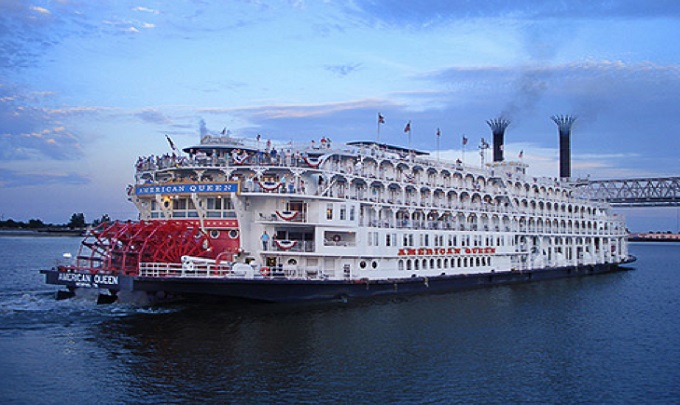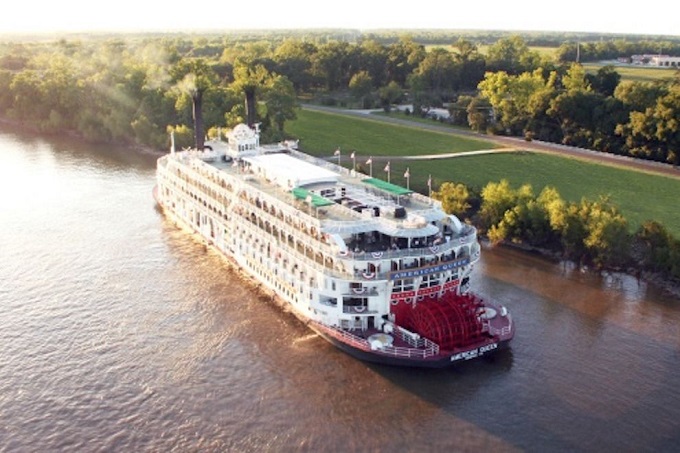'FOLLOW THE MUSIC, and you can’t miss the boat' the porter said. There was no mistaking the jubilant sounds of Dixie in its New Orleans birthplace, despite our ears still ringing from several nights of hanging out at Bourbon Street jazz joints and ticking off the must-dos like Preservation Hall et al. But now, here we are gazing up at American Queen the world’s largest, and only true steamboat in the US. Here on the mighty Mississippi - her ancestral home – she awaits her guests, resplendent in crisp white, balustrades festooned with tri-colour bunting, twin stacks standing tall like Abe Lincoln’s stovepipe hat, and an enormous red bustle of a paddlewheel at her stern - she was a set-designer’s dream, ready for actors to make their entrance. 
Accepting a glass of fizz and some tasty morsels from the welcome-aboard All-American crew, we enter an impressive lobby with grand staircase and enormous arrangement of fresh flowers beneath the sign: Historic Hotels of America. Following the music, we aim for the upper decks to ‘inspect’ our fellow travellers who presented as a cultured, cross-generational, multinational group who do country club casual dress-code so well. We had all had gathered to farewell New Orleans and watch the ebb and flow of the Big Muddy’s river traffic: giant containers, cruise ships, flatboats, push boats and pleasure boats. All made way for the illustrious queen while flares from oil rigs and power plants illuminated her progress until she headed upriver into more serene waters and wooded banks. Our six-day cruise of the Lower Mississippi would take us through America’s heartland from New Orleans’ Bourbon Street to Memphis’ Beale St – from Jazz, through Gospel and Blues, Ragtime, Country and Rock that would end at Graceland, Elvis’ shrine in Memphis. It was a journey into the culture and turmoil of the Deep South that fuelled the literary legacy of Mark Twain, William Faulkner, Tennessee Williams, and Harper Lee. The dinner gong for second sitting summoned us to the J.M. White dining room – a lovely light-filled space, with handsome high-backed chairs, perfectly-dressed tables with fine crystal, flatware, fresh flowers and menus featuring Cajun and Creole specialties created by renowned southern chef Regina Charbonneau. Breakfast and lunch were also served here, or at the Front Porch Café. Along from the dining room is the two-storey Grand Saloon reproduced in the style of a small-town 19th century ‘opry-house’. It provides an atmospheric setting for nightly shows or daily talks on river lore, steamboating stories and an impressive Mark Twain tribute actor. Stifle those yawns - there is seldom a spare seat to be found. It is great entertainment. The Saloon is based on Ford’s Theatre in Washington DC, but Lincoln’s private balcony is never occupied. American Queen’s resident company of entertainers comprise high-calibre singers, dancers and a 6-10 piece orchestra who are outstanding jazz musicians in their own right. And every night, into the wee small hours, you can hear some authentic Delta blues in the Engine Room Bar. After his watch, Captain - who plays a mean guitar himself sometimes joins in, to listeners’ delight as they watch the big red paddle churning through the waters of this vital industrial corridor and environmental treasure. By day, the Front Porch is a popular spot as guests sway to the rhythm of the river in rocking chairs or deck swings. But if a bridge looms into view, most go aloft to watch the queen’s stacks lower horizontally so she can pass beneath low bridges, often to the wheezy accompaniment of her calliope. A riverboat tradition, calliope music is not everyone’s iced tea, or should we say, mint julep? River cruising on the Lower Mississippi is unlike cruising Europe’s waterways. This is the rural south. But some historic port towns still survive and American Queen’s own hop on hop off buses allow you to choose to go ashore or not. The buses make a 15 minute circuit between stops and provide access to an intriguing sampler of the history and lifestyle of the Deep South - a study in contrast between opulent wealth built on slavery and grinding poverty. More in-depth, themed excursions which take you further afield attract a fee. Or you can ride one of the queen’s bikes. Of course, plenty of guests never want to venture ashore. They are perfectly content to read, write, play board games or cards in the Mark Twain Gallery where lovely period antiques and Tiffany-style lamps re-capture a bygone era, while a few ladies choose the tranquillity of the charming Ladies Parlour. Others work out in the gym, take a dip in the pool, or indulge in a spa treatment. 
|
In Natchez, we put the hop-on, hop-off bus to the test and tackle three “Gone with the Wind” - era antebellum mansions: Rosalie, Magnolia Hall, and Stanton Hall where we are greeted by crinoline-clad southern belles. Built by the planter-elite when cotton was king and Natchez the richest city in the USA, the predominantly Greek Revival-style mansions are often accessed by avenues of live oaks cobwebbed with Spanish moss, while beneath, are densely flowering azaleas. Our next port, Vicksburg had also seen more prosperous times before ‘the great unpleasantness’. It played a pivotal role in the Civil War. The battle and siege that took place here are etched into US history and American Queen’s exclusive tours of Vicksburg’s Civil War sites attract buffs from the world over. Meanwhile, this colourful old town with its chequered past doesn’t end here. The Old Court House Museum houses some macabre memorabilia such as notices of slave sales, and more cheerfully, an original Teddy Bear given by President Teddy Roosevelt. (The Roosevelts were pioneers in river boat history). Our Premium Experience shore excursion was at hand. We take to the road in a small bus following the Blues Trail to the birthplace of the Blues – Clarksdale, Mississippi. But first, we cross to Helena, Arkansas and file into the Greater First Baptist Church to hear the finest, most heartfelt gospel singing anywhere imaginable. Then on to Clarksdale’s Delta Blues Museum which traces the history and careers of Blues legends such as WC Handy, Muddy Waters, John Lee Hooker and others, then finally to Morgan Freeman’s, juke joint, Ground Zero – where we snacked on all manner of southern-fried tidbits. Wicked. But we had followed the music to its very source. Luxury Link: www.aqsc.com Maggy Oehlbeck, 17/7/17
|